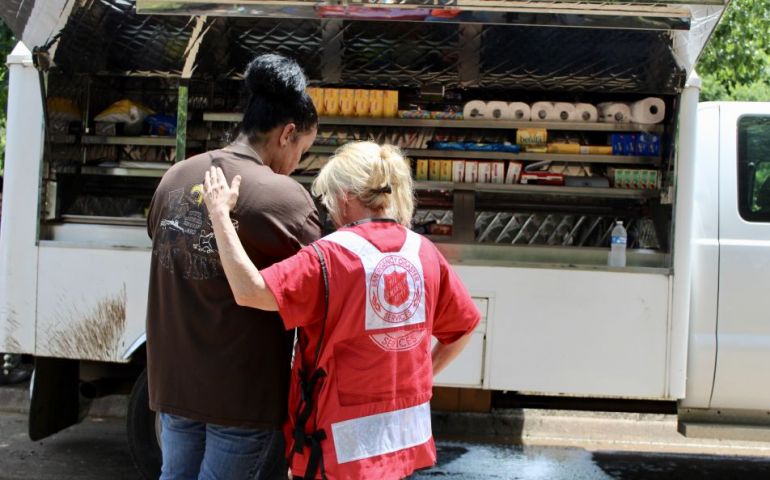The Salvation Army is Here!
Cindy Fuller | cindy.fuller@uss.salvationarmy.org | (405) 830-6549

“The Salvation Army is here! Now we can pray!” shouted Sharon as The Salvation Army “canteen” pulled up to her small house on a hot Saturday afternoon in Sand Springs, Oklahoma.
Sharon is the “neighborhood grandma” to many children in the two-block underserved neighborhood where she lives. Her house is always full of people - she welcomes one and all to sit at her table. She is the caregiver for her 32-year-old son who is quadriplegic after being stabbed five years ago.
The canteen crew met Sharon the day before as they served food in her small neighborhood. She invited them into her home full of children and shared her story. She asked them if they would come back the next day to pray with her son.
“Come back tomorrow when it is quieter. I would like for you to pray with my son.” The crew eagerly agreed. When disasters impact communities, The Salvation Army serves the whole person – physically, spiritually, and emotionally.
When the Salvation Army team arrived at Sharon’s house the next morning, they were led to a tiny bedroom with a broken, air conditioner unit. Sharon’s son lay on a special bed, waiting for the team. The crew of three gathered around his bed with 15 other people and prayed for him, his health, and his family.
“The Holy Spirit was in the room. It was present and right in the middle of us,” said one of the canteen workers. “The scripture that kept coming to my mind was 1 Peter 5:7. Cast all your anxiety on him because he cares for you. We were there to minister, but we were ministered to as well by this wonderful, faithful family.”
Emotional and spiritual care is a large component of The Salvation Army’s care during disaster response. As canteen (mobile feeding unit) crews roam neighborhoods, they often meet people who truly want more than just food for their bodies, they want food for the soul.
We can do this because of the public's generosity.
How People Can Help
The best way to help after a disaster is to make a financial donation to the charity of your choice. Cash is flexible, can be used immediately in response to a crisis, and allows disaster relief organizations to purchase exactly what is needed when it’s needed. Cash gives relief organizations the means to procure supplies near the affected area, which cuts down on transportation time and cost. Monetary contributions also support local economies and ensure that businesses can operate when relief supplies diminish.
- Donate Online: www.helpsalvationarmy.org
- Donate by Mail: The Salvation Army PO BOX 1959, Atlanta, GA 30301. Please designate 'May 2019 OK/AR Storms' on all checks.
- Donate by Phone: 1-800-SAL-ARMY (1-800-725-2769)
- Donate by Text: Text STORM to 51555 to receive a donation link for easy mobile giving
For the latest emergency disaster services news from The Salvation Army, follow the social feed on Twitter at @salarmyeds or visit disaster.salvationarmyusa.org.
About The Salvation ArmyThe Salvation Army annually helps more than 30 million Americans overcome poverty, addiction, and economic hardships through a range of social services. By providing food for the hungry, emergency relief for disaster survivors, rehabilitation for those suffering from drug and alcohol abuse, and clothing and shelter for people in need, The Salvation Army is doing the most good at 7,600 centers of operation around the country. In the first-ever listing of “America’s Favorite Charities” by The Chronicle of Philanthropy, The Salvation Army ranked as the country’s largest privately funded, direct-service nonprofit. For more information, visit www.SalvationArmyUSA.org. Follow us on Twitter @SalvationArmyUS and #DoingTheMostGood.